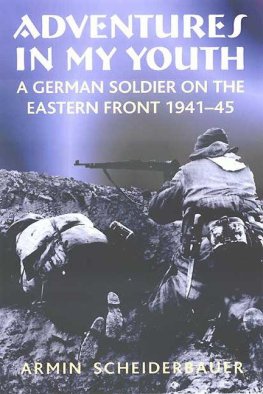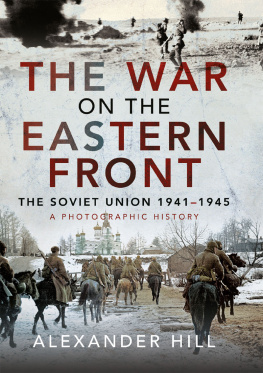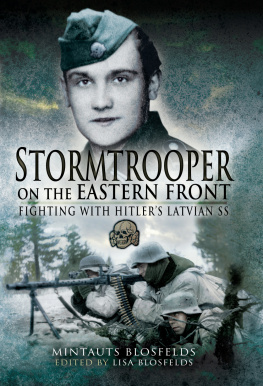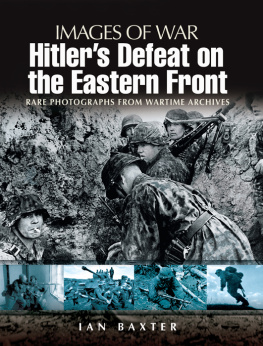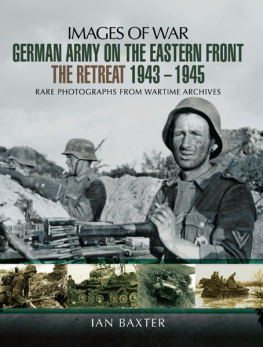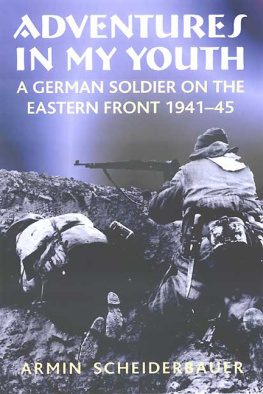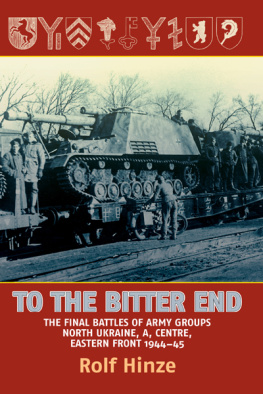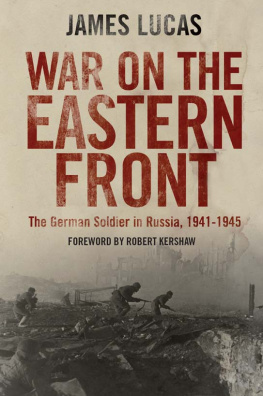Armin Scheiderbauer
ADVENTURES IN MY YOUTH
A GERMAN SOLDIER ON THE EASTERN FRONT
194145
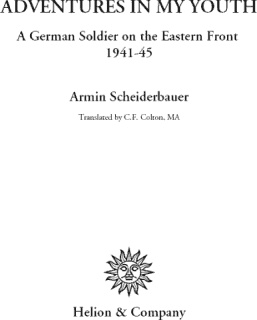
Many military terms have been retained in their original German, and readers are directed to the glossary for English definitions.
The publishers wish to extend their thanks to the author, Dr Armin Scheiderbauer, for his patience and support for this book. He has dealt with all our enquiries and requests with the utmost politeness and promptitude. Dr Sarah Williams kindly agreed to write the prologue, and the publishers would like to express their gratitude for her accurate work.
To provide some background to the authors experiences, it was felt that a brief summary of the wartime activities of the 252nd Infantry Division might prove useful to readers.
Formation
The division was created on 26 August 1939, as a so-called 4th Wave division, from replacement units of Wehrkreis VIII. At that time it consisted of:
Inf.Rgts. 452, 461, 472
All divisional-level units numbered 252
Combat history
1939
Polish campaign formed part of Kampfgruppe Gienanth, seeing action at Miltitsch, Herrnstadt, Krotoschin-Lissa, Grschen, Krben, Jarotschin and Wreschen. Security work in the Konin-Klesczew area, and Posen. Transported to the Western front, October 1939.
193940
West/French campaign assigned to 1st Army, attacked through the Maginot Line at Geblingen, Schweix, Willerwald, the Saar canal. Further offensive operations in the Vosges, Badonviller and Celles. Transferred to Poland in July 1940, where it remained until the invasion of the U.S.S.R.
1941
Eastern Front formed part of 4th Army, Army Group Centre, where it fought around Bialystok and in White Russia, June-September. In October it was with 4th Panzergruppe around Vyazma, and the drive on Moscow. On 11 November Inf.Rgt. 452 was disbanded, and replaced by Inf.Rgt. 7, from the 28th Inf.Div.
1942
Eastern Front With 4th Panzer Army until April, around Gshatsk, then with 3rd Panzer Army in the same area until the end of the year.
1943
Eastern Front Transferred to 4th Army, with which it served at Jelnja, February to October. In November it returned to 3rd Panzer Army, around Orsha and Nevel. Grenadier Regt. 472 was temporarily inactive between 25 February 1943 and July 1944.
1944
Eastern Front Remained with 3rd Panzer Army for much of the year, through Operation Bagration and the withdrawal to Lithuania. In July, the Division was reorganised as follows:
Gren.Regts. 7, 461, 472
All divisional-level units continued to be numbered 252
Transferred to 2nd Army in October, around the Narev bridgehead, Poland.
1945
Eastern Front Defended the Narev area in the Soviet Vistula-Oder offensive, and subsequent retreat to West Prussia. Although much of the remnants of the Division escaped to Bornholm, they were repatriated to Kolberg, and Soviet captivity.
Bibliography
For those wishing to read more about 252nd I.D. and Grenadierregiment 7 the following are recommended:
Walter Melzer Geschichte der 252. Infanterie-Division 19391945 (Podzun Verlag, 1960)
Romuald Bergner Schlesische Infanterie. Grenadier-Regiment 7. Das Infanterie-Regiment 7 und seine Stamm-Truppenteile in Krieg und Frieden. Eine Chronik schlesischer Infanterie 18081945 (Pppinghaus, 1980)
Armin Scheiderbauer was born on 13 January 1924 in Grbming, eastern Styria, the eldest son of a Protestant minister. Armins parents were Austrian, and in later life Armin himself retained a sense of Styrian identity. However, in 1930 his parents moved to Thuringia, in order to gain some experience of church life in the homeland, and it was here, in Germany, that he spent the greater part of his childhood.
Armins early years were happy ones, spent in a series of small rural communities. He recalls his days in village schools and friendships with local children with considerable affection. The family was a close and happy one, and frequent visits from relatives and neighbouring ministers created a busy and lively atmosphere in the vicarage. Every aspect of daily life in the vicarage was moulded by religion. Prayers were said in the morning, evening, and at mealtimes, and from an early age Armin was actively involved in the church itself, not only attending services but acting as a bell-ringer and as an organ-pumper on Sundays. Within the family church holidays, such as Reformation Day, were important staging posts of the year. Armins confirmation and the course of preparatory lessons which preceded it marked an important rite of passage in the boys early life. In later life he looked back on the vicarage and its values the emphasis on duty, positive action, and putting Christian virtues into practice in daily life as being a lasting influence on his ideas and outlook.
Religion was not, however, the only important influence on Armins social and psychological development. From an early age he took a particular interest in history, and his ideas about Germany and its place in the world were formed in his early childhood. The events of the Great War and the injustice of its outcome were something of which Armin was aware from his earliest years at school. In particular he knew about and was proud of the medals which his own father had gained for service in that conflict. Two events at school played a particular part in developing Armins sympathy with nationalistic sentiments. The first was a visit from a participant in the sea-battle outside Skaggerak, who had survived the famous sinking of the cruiser Frauenlob. This inspired in the young Armin an ambition to join the navy, perhaps as a U-boat officer. The second was the performance of the plays Wallenstein and Egmont by Goethe, which awoke in Armin a strong admiration for military valour and an interest in the heroic ideal. These impressions were strengthened by other nationalistic influences in the environment: a series of images from German history on cigarette cards made a particular impression on his imagination, as did the books detailing subjects such as the history of Germanys lost colonies which he received as school prizes. Even as a boy Armin had developed the conviction a career in the armed forces would be the most honourable path that he could aspire to.
In the later years in Thuringia political developments, as well as the general nationalistic tone of the period, began to have an impact on Armins family. In 1931 Armins parents joined the NSDAP. As Protestants they were attracted to the Nazi appeal to positive Christianity; this appealed to their perception that the Augsburg confession as inextricably linked to the idea of German national identity. Armins uncle (who was also his godfather) was even more politically engaged; he fled to the Reich following the failure of the July putsch of 1934 and was a member of the Austrian legion. Armin himself was a member of the Hitler Youth, serving as a banner-bearer and later as treasurer. From 1934, however, the family found itself swimming increasingly against the political tide. As Nazi control of the church grew, and as their intrusion into doctrinal questions increased their insistence, for example, that the Old Testament was a tainted Jewish text which should not be taught in church Armins father felt compelled to join the bekennende Kirche movement, which opposed the Nazi inspired deutsche Christens influence within the church. Although never expelled from the party, Armins father was subjected to hostile interrogations on a number of occasions. Faced with the distrust of the Church hierarchy, and even of members of his own congregation in Thuringia, Armins father felt compelled to seek a position in Austria. Yet members of the Protestant church in Austria felt suspicious of a man returning from the Church in the homeland. It was only with some difficulty that his father found a new position, and even then it was as an assistant minister a demotion which was not only painful to his feelings, but which also entailed a significant deterioration in the financial circumstances of the family.

